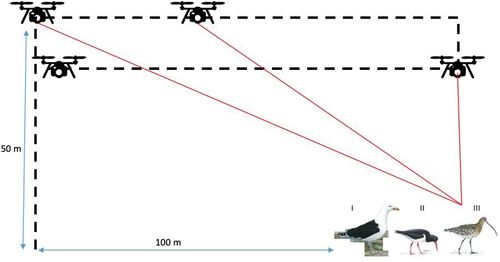LC 00535: verschil tussen versies
Geen bewerkingssamenvatting |
Geen bewerkingssamenvatting |
||
| Regel 3: | Regel 3: | ||
In this experiment, stuffed seabirds were used as stand-ins for live seabirds. Images of the stuffed birds were captured by the drone. In each iteration of this experiment, the drone was placed on the ground, 100 metres away from the decoy birds. The drone then took off and flew vertically until an altitude of 50 metres was reached. A first transect was then completed by flying the drone 100 metres in the direction of the birds. Images were captured approximately every 2 metres, and the angle of the camera was adjusted for each image such that the camera was always pointed toward the decoy birds. Once the first transect was completed, the drone descended 5 metres to an altitude of 45 metres and flew 100 metres in the direction of this origin. Additional transects were completed in this fashion until an altitude of 10 metres was reached. Figure 1 provides an illustration of this methodology. | In this experiment, stuffed seabirds were used as stand-ins for live seabirds. Images of the stuffed birds were captured by the drone. In each iteration of this experiment, the drone was placed on the ground, 100 metres away from the decoy birds. The drone then took off and flew vertically until an altitude of 50 metres was reached. A first transect was then completed by flying the drone 100 metres in the direction of the birds. Images were captured approximately every 2 metres, and the angle of the camera was adjusted for each image such that the camera was always pointed toward the decoy birds. Once the first transect was completed, the drone descended 5 metres to an altitude of 45 metres and flew 100 metres in the direction of this origin. Additional transects were completed in this fashion until an altitude of 10 metres was reached. Figure 1 provides an illustration of this methodology. | ||
Two iterations of this experiment were performed on two separate days. On the first day, conditions were overcast. On the second day, conditions were sunny. | Two iterations of this experiment were performed on two separate days. On the first day, conditions were overcast. On the second day, conditions were sunny. | ||
[[Bestand:Bird decoys.jpg|gecentreerd|miniatuur| | [[Bestand:Bird decoys.jpg|gecentreerd|miniatuur|850x850px|Figure 2: Bird decoys. From left to right: Seagull, Oystercatcher, Lesser black-backed gull, Seagull, Spur-winged lapwing.]] | ||
Five seabird specimens were used in this experiment. Four out of the five specimens represent species commonly found in northwestern Europe. The one exception to this rule was the spur- winged lapwing specimen, which was used a stand-in for the wader species that do frequent the area but more important also represent a different size when compared to the other species (Figure 2) . | Five seabird specimens were used in this experiment. Four out of the five specimens represent species commonly found in northwestern Europe. The one exception to this rule was the spur- winged lapwing specimen, which was used a stand-in for the wader species that do frequent the area but more important also represent a different size when compared to the other species (Figure 2) . | ||
{{Light Context | {{Light Context | ||
|Supercontext=LC_00433 | |Supercontext=LC_00433 | ||
Versie van 12 nov 2020 15:23
The drone surveys were performed at Viane tidal flat with an Inspire 2 drone, an off-the-shelf drone model from SZ DJI Technology Co., Ltd. (DJI). An off-the-shelf model, as opposed to a customized unmanned aerial system, was chosen for this study. There were two motivations behind this decision. The first was cost. Off-the-shelf drones are generally cheaper thanks to the economies of scale afforded to the manufacturer by virtue of producing them in relatively large quantities. The second was ease of implementation. Drone monitoring programmes will be easier to implement if they can be setup starting with a simple purchase of a ready-to-use drone.
In this experiment, stuffed seabirds were used as stand-ins for live seabirds. Images of the stuffed birds were captured by the drone. In each iteration of this experiment, the drone was placed on the ground, 100 metres away from the decoy birds. The drone then took off and flew vertically until an altitude of 50 metres was reached. A first transect was then completed by flying the drone 100 metres in the direction of the birds. Images were captured approximately every 2 metres, and the angle of the camera was adjusted for each image such that the camera was always pointed toward the decoy birds. Once the first transect was completed, the drone descended 5 metres to an altitude of 45 metres and flew 100 metres in the direction of this origin. Additional transects were completed in this fashion until an altitude of 10 metres was reached. Figure 1 provides an illustration of this methodology. Two iterations of this experiment were performed on two separate days. On the first day, conditions were overcast. On the second day, conditions were sunny.
Five seabird specimens were used in this experiment. Four out of the five specimens represent species commonly found in northwestern Europe. The one exception to this rule was the spur- winged lapwing specimen, which was used a stand-in for the wader species that do frequent the area but more important also represent a different size when compared to the other species (Figure 2) .


